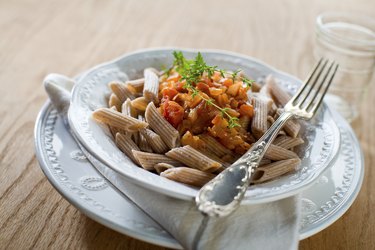
Most pasta products on supermarket shelves contain wheat flour. Exceptions include rice noodles or pasta that has been made using ingredients other than wheat, such as buckwheat or mung bean starch. The difference between what many people commonly refer to as "white" pasta and "wheat" pasta is that "white" pasta is made using mostly refined wheat flour, while "wheat" pasta is made using mostly whole wheat flour.
Physical Differences
Video of the Day
A kernel, or seed, of flour is made up of three parts – the bran, germ and endosperm. Whole wheat flour is made by grinding up all three of these parts together. Refined wheat and white flour, on the other hand, has been milled to remove the bran and germ from the kernel. Refined wheat and white flour is made by grinding up only the endosperm portion of the grain. The process of refining gives the flour a finer texture and longer shelf life but also results in lower amounts of some beneficial nutrients. According to national food labeling regulations, a product such as pasta that is labeled as "whole wheat" must contain at least 51 percent whole wheat flour. A product that is simply labeled "wheat" contains wheat but may or may not contain whole wheat flour.
Video of the Day
Fiber Content
Whole wheat pasta is higher in fiber than pasta made with refined wheat, or "white," pasta. Fiber is found in the germ and bran of a wheat kernel. When the germ and bran are removed during the refining process, most of the fiber is removed as well. One cup of cooked, whole wheat spaghetti contains approximately 6 grams of fiber, while the same amount of white spaghetti contains less than half that amount. Fiber plays an important role in your body by helping to remove cholesterol and maintain regularity. Consumption of dietary fiber that occurs naturally in foods, such as that in whole wheat, may help to lower risk of cardiovascular disease, obesity and type-2 diabetes. In addition, fiber can help you to feel fuller for longer by slowing down the rate at which your stomach empties. The Dietary Guidelines for Americans recommends that adult women consume approximately 25 grams of fiber per day, while men should aim for 38 grams of fiber per day.
Vitamins and Minerals
The refining process also removes iron and many of the B vitamins that are found naturally in whole wheat. One cup of whole wheat pasta contains more thiamin, riboflavin and niacin than a similar amount of white pasta. In the United States, however, most grain products are enriched, meaning that vitamins and minerals have been added to them. Pasta made with enriched white flour will contain B vitamins in levels at least as high, or higher, than those found in whole wheat pastas.
Protein and Carbohydrates
Whole wheat pasta and white pasta contain similar amounts of protein and carbohydrate. A 1-cup serving of whole wheat spaghetti provides approximately 7 grams of protein and 37 grams of carbohydrates, while 1 cup of white pasta provides approximately 8 grams of protein and 43 grams of carbohydrates. While these slight differences in protein and carbohydrate levels probably will not matter much to most consumers, diabetics who are counting carbohydrates may choose to opt for lower-carbohydrate whole wheat pasta.
Cooking and Taste Differences
While whole wheat pasta generally takes slightly longer to cook than white pasta, this is not always the case. For example, one brand suggests a cooking time of nine minutes for its regular (white) spaghetti, and seven minutes for its whole wheat spaghetti. Whole wheat pasta can have a chewier, gummier texture than white pasta. While this may be off-putting for some people, others may enjoy a heartier texture. The Dietary Guidelines for Americans recommends that adults consume at least three servings per day of whole-grain foods. Choosing whole wheat pasta rather than white pasta, in addition to choosing other whole grains such as brown rice, whole-grain bread, whole-grain cereals or oatmeal can help people to meet this recommendation.
- Food and Drug Administration: Health Claim Notification for Whole Grain Foods
- HealthAliciousNess.com
- U.S. Department of Agriculture: 2010 Dietary Guidelines for Americans
- Barilla
- DietaryGuidelines.gov: 2010 Dietary Guidelines for Americans
- Harvard School of Public Health: Health Gains from Whole Grains
- ChooseMyPlate.gov